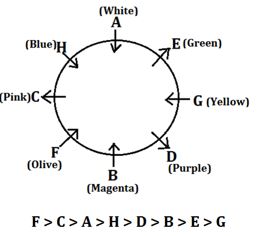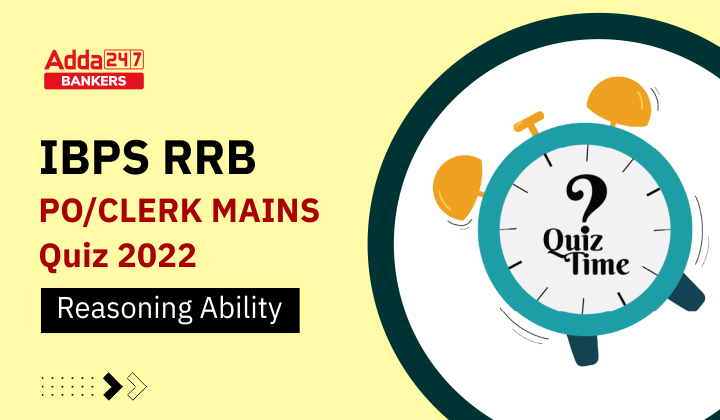Directions (1-5): Study the following information and answer the given questions:
Eight persons are sitting around a circular table in such a way some are facing inside while some are facing outside. All persons are different ages and likes different colours.
F sits third to the left of G who likes yellow colour. A is third oldest person and sits second to the right of the second oldest person who likes pink colour. The one who likes blue colour sits immediate right of the one who likes white colour. Two persons sit between B and E who is an immediate neighbour of G. F sits third to the right of A. D is older than only three persons. H sits second to the left of the one who likes olive colour. C is younger than F but older than D. Neither B nor E likes olive colour. Second youngest person likes green colour. The one who likes magenta colour sits immediate right of the oldest person. E is older than G but younger than H who faces inside. The one who likes purple sits third to the left of the one who likes white colour. B and A faces each other. D and E facing same direction but opposite to G. B is younger than H.
Q1. Who among the following person sits second to the left of third youngest person?
(a) the one who likes white colour
(b) the youngest person
(c) the one who sits second to the right of A
(d) G
(e) None of these
Q2. Who among the following person likes Olive colour?
(a) F
(b) A
(c) C
(d) D
(e) None of these
Q3. Which of the following statement is not true about D?
(a) D likes purple colour
(b) the one who likes Blue colour is younger than D
(c) D is older than E
(d) D sits second to the right of F
(e) All are true
Q4. How many persons sits between H and G, when counted right of G?
(a) One
(b) Three
(c) None
(d) Two
(e) More than four
Q5. Which of the following colour likes by third oldest person?
(a) Blue
(b) White
(c) Magenta
(d) Pink
(e)None of these
Directions (6-10): A word and number arrangement machine when given an input line of words and numbers rearranges them following a particular rule in each step. The following is an illustration of input and rearrangement.
Input: reforms 31 sector technology 96 home 14 49 local business 22 47
Step I: 5 reforms 31 sector technology 96 49 local business 22 47 home
Step II: 13 5 reforms 31 sector technology 96 49 business 47 home local
Step III: 35 13 5 reforms technology 96 49 business 47 home local sector
Step IV: 51 35 13 5 technology 96 49 business home local sector reforms
Step V: 53 51 35 13 5 technology 96 home local sector reforms business
Step VI: 87 53 51 35 13 5 home local sector reforms business technology
As per the rules followed in the steps given above, find out in each of the following questions the appropriate step for the given input.
Input: 54 factory 33 income 17 26 dark 42 sport 87 optimism governance
Q6. Which of the following element is 7th from the left in step III?
(a)54
(b)Factory
(c) 87
(d)Dark
(e)None of these
Q7. Which of the following element is exactly middle in ‘17’ and ‘income’ in step V?
(a)income
(b) Governance
(c)42
(d)33
(e)None of these
Q8. What is multiplication of smallest digit in step II and third highest digit in step V?
(a) 725
(b) 629
(c)100
(d) 275
(e) None of these
Q9. Which of the following element is third to the left of the element which is fourth to the right in step III?
(a)Optimism
(b)87
(c) 42
(d)Factory
(e)None of these
Q10. Which of the following element is 5th from the right in last step?
(a)Sport
(b)factory
(c)Income
(d)dark
(e)None of these
Directions (11-12): In making decision about important questions, it is desirable to be able to distinguish between “strong” arguments and “weak” arguments. “Strong” arguments must be both important and directly related to the question. “Weak” arguments may not be directly related to the question and may be of minor importance or may be related to the trivial aspects of the question.
Each question below is followed by two arguments numbered I and II. You have to decide which of the argument is a “strong” argument and which is a “weak” argument.
Give answer (a) if only argument I is strong.
Give answer (b) if only argument II is strong.
Give answer (c) if either argument I or II is strong.
Give answer (d) if neither argument I nor II is strong.
Give answer (e) if both arguments I and II are strong.
Q11. Should graduation be made minimum educational qualification for entry level jobs in any public sector organization?
Arguments:
I: Yes, graduates always perform better than the non-graduates by virtue of their higher level of education.
II: No, there are quite a few people who cannot afford to remain un-employed till the completion of graduation and are capable of performing equally well as the graduate candidates.
Q12. Should the examination bodies for all university examination permit the use of calculators?
Arguments:
I: No, it is necessary for the students to know the methods of manual calculation to make their concepts clear.
II: Yes, manual calculations are no more required with extensive use of computers in all fields.
Directions (13-15): In the following questions, the symbols @, &, *, # and % are used with the following meaning as illustrated below.
‘P # Q’ means ‘P is smaller than Q’.
‘P @ Q’ means ‘P is smaller than or equal to Q’.
‘P * Q’ means ‘P is greater than or equal to Q’.
‘P % Q’ means ‘P is equal to Q’.
‘P & Q’ means ‘P is greater than Q’.
Now, in each of the following questions assuming the given statements to be true, find which of the two Conclusions I and II given below them is/are definitely true and give your answer accordingly.
Q13. Statements: I # A ; A & B & C* D@ E; B&F ;E#H ;G&D
Conclusions: I. A&D
II. D#H
(a) Only I is true
(b) Only II is true
(c) Neither I nor II
(d) Either I or II is true
(e) Both I and II are true
Q14. Statements: S & R & L; L & M @ N * O % P & Q ; N # T
Conclusions: I. T&Q
II. T%Q
(a) Both I and II are true
(b) Only I is true
(c) Only II is true
(d) Either I or II is true
(e) Neither I nor II true
Q15. Statements: V # P ; S % U ; W % R ; P & Q * R @ S % T
Conclusions: I. T @ W
II. R* V
(a) Only I is true
(b) Only II is true
(c) Neither I nor II
(d) Either I or II is true
(e) Both I and II are true
Solutions
Solution (1-5):
Sol.

S1. Ans. (c)
S2. Ans. (a)
S3. Ans. (b)
S4. Ans. (d)
S5. Ans. (b)
Solutions (6-10):
Sol. Students let us understand the Logic behind this Question and let’s understand how to solve it. As a first step lets first understand the logic behind the Output. If you will see the final output, you will observe the following:
(i)- In each step only one word and one number are getting arranged. The words are arranged according to the number of letters present in words in ascending order from left end to right end.
(ii)- Numbers are arranged increasing order right to left. If number is even number subtract square of 3(i.e., 9) in this number and if number is odd number add square of 2(i.e., 4) in this number.
Input: 54 factory 33 income 17 26 dark 42 sport 87 optimism governance
Step I: 21 54 factory 33 income 26 42 sport 87 optimism governance dark
Step II: 17 21 54 factory 33 income 42 87 optimism governance dark sport
Step III: 37 17 21 54 factory 42 87 optimism governance dark sport income
Step IV: 33 37 17 21 54 87 optimism governance dark sport income factory
Step V: 45 33 37 17 21 87 governance dark sport income factory optimism
Step VI: 91 45 33 37 17 21 dark sport income factory optimism governance
S6. Ans. (c)
S7. Ans. (b)
S8. Ans. (b)
S9. Ans. (c)
S10. Ans. (a)
S11. Ans. (b)
Sol. In a country where welfare is accorded high priority, stricter rules cannot be applied. Further, there is no need to make graduation the minimum educational qualification for entry level jobs in any public sector organization. Hence, Argument I is not strong Argument II is logically convincing.
S12. Ans. (a)
Sol. Only argument I seems to be strong. Any electronic device like computer can be used effectively if the concepts are clear.
S13. Ans.(e)
Sol. I. A&D(True)
II.D#H(True)
S14. Ans.(b)
Sol. I.T&Q(True)
II.T%Q(False)
S15. Ans.(c)
Sol. I. T@W (False)
II.R*V(False)





 GA Capsule for SBI Clerk Mains 2025, Dow...
GA Capsule for SBI Clerk Mains 2025, Dow...
 The Hindu Review October 2022: Download ...
The Hindu Review October 2022: Download ...
 ECGC PO Cut off 2025 Out, Check Final Cu...
ECGC PO Cut off 2025 Out, Check Final Cu...




